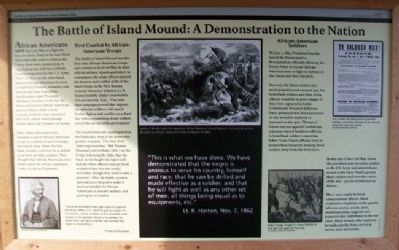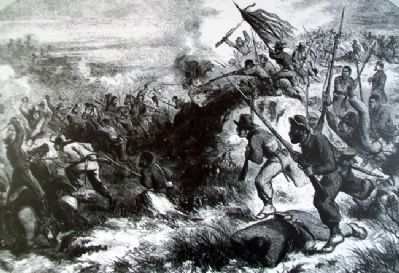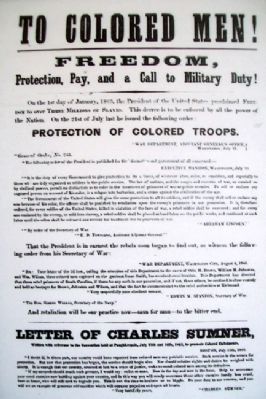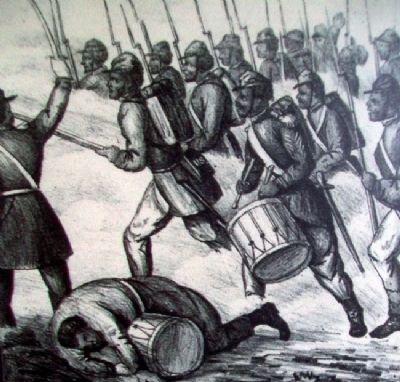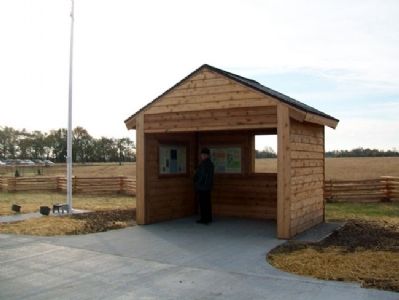Near Butler in Bates County, Missouri — The American Midwest (Upper Plains)
The Battle of Island Mound: A Demonstration to the Nation
Inscription.
African Americans saw the Civil War as a fight for their freedom. Early in the war, freed black men who tried to enlist in the Union Army were turned away. A 1792 Federal law still barred blacks from bearing arms for the U.S. Army. The U.S. Navy, on the other hand, allowed African Americans to serve as shipboard firement, stewards, coal heavers and even boat pilots. Abolitionists urged President Abraham Lincoln to both free the slaves and recruit African-American men in defense of the Union. Lincoln, however, was concerned that such a move would prompt border states, like Missouri, to secede.
Many white Americans were reluctant to allow African-American troops in combat because of deeply held racist ideas. Many felt that black soldiers could not be as skilled or as brave as white soldiers. They thought that African Americans were better suited for jobs as carpenters, cooks, scouts and teamsters.
First Combat by African-American Troops
The Battle of Island Mound was the first time African-American troops saw combat in the Civil War. In their official military reports and letters to newspapers, the white officers praised the bravery and combat skills of the black troops in the First Kansas Colored Volunteer Infantry. Lt. R. Hinton told the Daily Conservative of Leavenworth, Kan., "Our nine days campaign proved that negroes are splendid soldiers, will march further, fight as well, and live on as hard fare without grumbling, as any soldiers now in the service of the government."
The Southerners who participated in the battle also went to the press with positive remarks. The New York Times reported that, "Bill Truman [Turman] told in Butler [Mo.] on the Friday following the fight, that the black devils fought like tigers and that the white officers had got them so trained that not one would surrender, though they tried to take a prisoner." After the battle, positive national press helped to make it more acceptable for African Americans to join the military and participate in combat.
African-American Soldiers
On Jan. 1, 1863, President Lincoln issued the Emancipation Proclamation, officially allowing the Union Army to recruit African-American men to fight in defense of the Union and their freedom.
Not only did black soldiers face racial prejudice and unequal pay, but both black soldiers and their white officers would be in grave danger if they were captured in battle. Confederate President Jefferson Davis promised that black prisoners of war would be enslaved or executed on the spot. Threats of Union reprisal against Confederate prisoners forced Southern officials to treat black soldiers somewhat better. Some Union officials
tried to protect their troops by keeping black soldiers away from the front lines.
By the end of the Civil War, about 180,000 black men served as soldiers in the U.S. Army and almost 18,000 served in the Navy. Nearly 40,000 black soldiers died over the course of the war - 30,000 of infection or disease.
There were nearly 80 black commissioned officers. Black carpenters, chaplains, cooks, guards, laborers, nurses, scouts, spies, steamboat pilots, surgeons and teamsters also contributed to the war cause. Black women, who could not formally join the Army, served as nurses, spies and scouts.
"This is what we have done. We have demonstrated that the negro is anxious to serve his country, himself and race; that he can be drilled and made effective as a soldier; and that he will fight as well as any other set of men; all things being equal as to equipments, etc."
Lt. R. Hinton, Nov. 7, 1862
Erected 2012 by Missouri Department of Natural Resources.
Topics and series. This historical marker is listed in these topic lists: African Americans • Civil Rights • War, US Civil. In addition, it is included in the Former U.S. Presidents: #16 Abraham Lincoln series list. A significant historical month for this entry is January 1986.
Location. 38° 14.194′ N, 94° 26.336′ W.
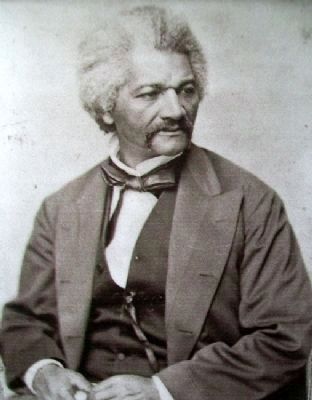
Photographed By Unknown, undated
3. Frederick Douglass Image on The Battle of Island Mound: A Demonstration to the Nation Marker
[Caption reads] "Once let the black man get upon his person the brass letter, U.S., let him get an eagle on his button, and a musket on his shoulder and bullets in his pocket, there is no power on earth that can deny that he has earned the right to citizenship."
Frederick Douglass
Image courtesy Library of Congress
Frederick Douglass
Image courtesy Library of Congress
Other nearby markers. At least 8 other markers are within 6 miles of this marker, measured as the crow flies. First Kansas Colored Volunteer Infantry Regimental History (here, next to this marker); The Battle of Island Mound (here, next to this marker); Battle of Island Mound Memorial (within shouting distance of this marker); The Toothman Farm (about 400 feet away, measured in a direct line); Bates County, Missouri in 1862 (approx. 0.2 miles away); Prairie Fire and the Battle of Island Mound (approx. 0.2 miles away); Replica of the Statue of Liberty (approx. 5.6 miles away); Butler History Murals (approx. 5.9 miles away). Touch for a list and map of all markers in Butler.
Also see . . .
1. The Battle of Island Mound. (Submitted on October 28, 2012, by William Fischer, Jr. of Scranton, Pennsylvania.)
2. First Kansas Colored Infantry. (Submitted on October 28, 2012, by William Fischer, Jr. of Scranton, Pennsylvania.)
3. Battle of Island Mound State Historic Site. (Submitted on October 28, 2012, by William Fischer, Jr. of Scranton, Pennsylvania.)
4. The Civil War in Missouri. (Submitted on October 28, 2012, by William Fischer, Jr. of Scranton, Pennsylvania.)
Credits. This page was last revised on December 15, 2020. It was originally submitted on October 28, 2012, by William Fischer, Jr. of Scranton, Pennsylvania. This page has been viewed 831 times since then and 25 times this year. Photos: 1, 2, 3, 4, 5, 6. submitted on October 28, 2012, by William Fischer, Jr. of Scranton, Pennsylvania. 7. submitted on October 27, 2012, by William Fischer, Jr. of Scranton, Pennsylvania.
